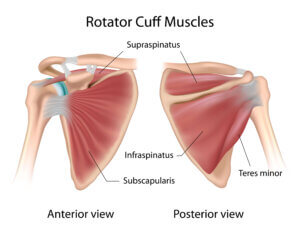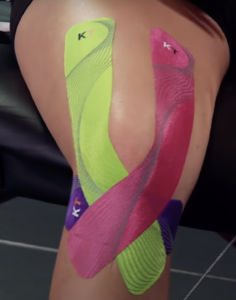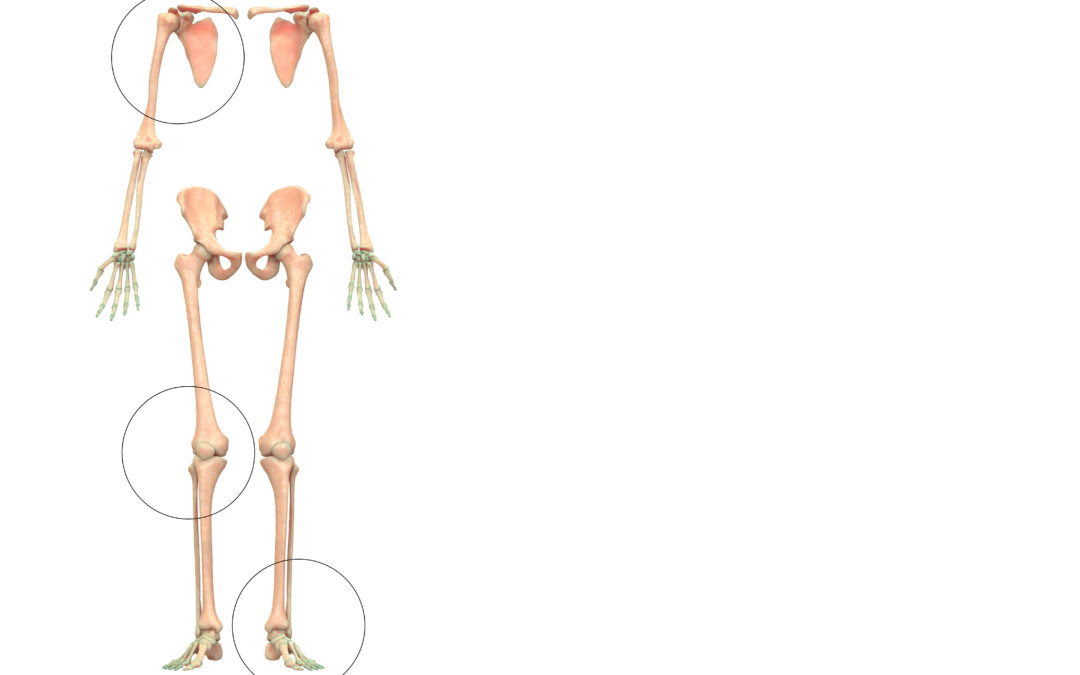An Introduction and Practical Guide for Taping for Joint Problems
We can use commercially developed braces and soft forms of splinting to support joints and soft tissue (ligaments and muscle) to limit pain, support function and, above all, provide continuing activity whilst limiting damage. Tapes adhered to the skin have been promoted as an adjective for achieving the same aim. In this article, I will bring some ideas into focus about taping (strapping). While you can undertake these at home, placement and technique are best applied with someone to aid your technique. However, reach is a little easier as you get to the knee and ankle.
Focusing on the shoulder, the knee and the ankle provides an idea of how assistance can be used, and I have delved into my own experience as a patient. It is important to distinguish whether it is tendon pain or muscle/ligament strain to apply the correct tension and direction of strapping. This article is intended as a starter guide. Professional guidance is always recommended from a physiotherapist or equivalent registered professional experienced in musculoskeletal management. Examples of anatomy methods are linked to reputable information sites from physiotherapists, podiatrists and chiropractors. For more information on rotator cuff injury, you can read my five-part articles covering my experience as a patient, available from January 2024.

BEWARE OF RISKS WITH TAPING
Damage to the skin is always possible. In the past, tapes were made of a fabric coated with an adhesive to which zinc oxide (ZO) was applied to minimise irritation. Allergies arose because of certain rubbers mixed in with the adhesive. Low allergy tapes then entered the market using a different grade material, but even these can irritate the skin.
The second cause of irritation is not an allergy but poor technique. Creases and sections lift after use. Moisture and movement of tapes damage skin and cause redness, blistering and peeling of the top layer. In the worst-case scenario, the wound weeps, takes a week or so to heal and can leave a scar. Localised pain fails to subside, and discomfort continues as burning-prickly pain. Unfortunately, this happened to me when I used shoulder strapping as a self-help strategy.
CHECKING VIDEOS
Videos should ideally be short, I try for under four minutes) and clearly presented to understand without selling products. I have selected a few for my article, but many are out there.
MANY BRANDS EXIST
The groups that should be careful include anyone with a known skin problem that blisters or is easily damaged. Normal sensation must be appreciated, and areas associated with injury, wounds, infections, scarring and old surgery scars should be avoided without professional guidance. Large areas should not be exposed to taping, and hair is best reduced or shaved. The skin should be dry – sweaty skin fairs poorly from taping. Kinesiotaping – KT is a modern tape that is low in allergy risk, bonds well to the skin without any additional gums and allows stretch to work in favour of directional anchorage. Kinesio, or kinesiology tape, is a fancy brand name. but many such methods and ZO are taping still works well.
REASONS TO USE TAPING
The indications for taping are based on rest while allowing some activity provided that the pain, symptoms or injury won’t deteriorate. While KT is now very popular, some of the old materials remain to have benefits. Rigid ZO tapes can offer better limitation of movement, as in the great toe with fan strapping. I produced this short video to help patients with big toe pain.
LETS LOOK AT THE BIG JOINTS
Shoulder
The shoulder is a big round joint with a large muscle mass on the front and back of the upper body. It is worth following a professionally produced video. (NB YouTube videos may contain adverts). To show how the shoulder can be stabilised. Undertaking this yourself is not as easy as other parts of the body—the joint moves in all directions, aided by its round surface and socket. Taping supports weak muscles and the all-important rotator cuff. The idea is to limit the damage to the softer tissue structures around the shoulder. The effectiveness is short-lived without supplementary treatment.

NAT Global Therapies (accessed Sept. 2023) from the video above

Knee
The knee is completely different to the shoulder as it has a limited range of movement direction. The article teachme anatomy is useful when considering the knee. The joint extends and flexes but is most unstable when flexed, coming down and going up inclines like stairs and hills. Common injuries include the anterior cruciate ligament and meniscus on the inner side of the knee. The knee cap also suffers from instability and splitting of the soft cartilage on the inner surface causes pain and can be stabilised.
The video shows a method of knee taping. Many videos, such as this one, show only young people and athletes, but you don’t need to be young to use taping. We must remember that good skin preparation is vital. When active, problems include sweating and warmth around the tape so it can slip. In real terms of options when considering taping, it is best to appreciate how you are using your body – athletics, for rest in a sedentary job, or even gentle walking. Taping is fine for short periods or while waiting to see a professional. Heavy taping so it encases joints is less desirable and tends to cause added skin problems. Light taping, as shown, is intended to be placed in the direction of the greatest strain and to supplement weaker structures. The internet is teaming up with different designs.

Kinesiotaping is light, very colourful and has a backing strip. (see video)
Ankle
The Ankle is unique as it has a central bone (talus) clasped between the leg and sits on the heel bone (calcaneus). The principle movement is flexion and extension, but the accessory movement comes from under the central bone – inversion and eversion. The commonest form of injury is through a sprain, often temporary but overstretched with bruising and tenderness. Taping can take the form of a figure of 8 or stirrup strapping. The stirrup tape. One thing all videos have in common is the anchor strap, so at least one loop is made around the leg.
Braces and soft splints are available, but often, patients find bulky splints fit shoes poorly. The idea of taping is to put less bulk in the shoe and to remain active while a sprain settles. The other type of problem that exists is tendon pain. Reducing tendon movement can help reduce pain and settle inflammation without deeper tendon problems. The same problem can arise in the shoulder with the biceps tendon. I viewed several videos for the ankle and have to say there are many different videos and varied methods. The one I chose was short and did not encircle the ankle more than once. I do not believe in too much tape, but if swelling arises and the leg is encircled with rigid tape, the circulation may be reduced – not a good idea for the older patient. Most videos focus on the sports people as young, agile and healthy, which is not always the best example.
 To Tape or Not to Tape?
To Tape or Not to Tape?
A recent (2019) article points to the limited effects of taping failing to nullify footwear influencing problems. Still, it does not consider the benefit to patients with the temporary conditions mentioned in this article. Research is often limited in scope and removes the empirical benefits often seen through the decades of experience by hands-on practitioners. In an older article, the basis for helping with proprioception, a nerve reflex process, is supported in an article under peak performance. In another paper, the following conclusions are made about taping.
To my mind, this statement is more powerful than anything else. “Although taping the ankle did not affect performance, except to improve stair descent, it increased self-efficacy and perceived confidence in dynamic tasks. These findings suggest that taping may reduce apprehension without affecting functional performance in those with functional ankle instability and permit continued physical activity or sport participation.” Halim-Kertanegara, 2017
Thanks for reading my starter Guide for Taping. Written for consultingfootpain and published by Busypencilcase Communication November 2023
The author produces articles and books on various health aspects and encourages people to share their experiences freely.


Recent Comments